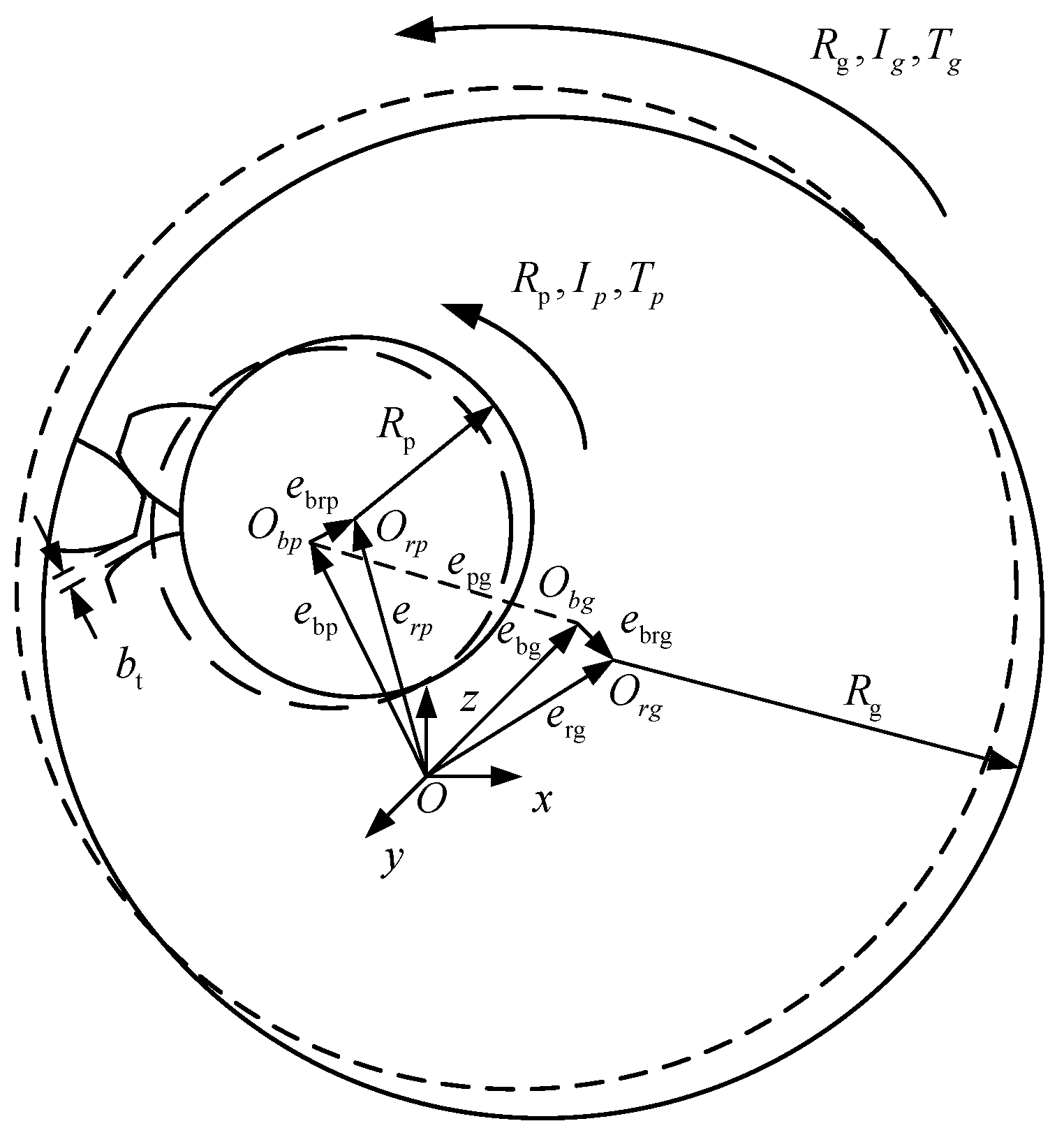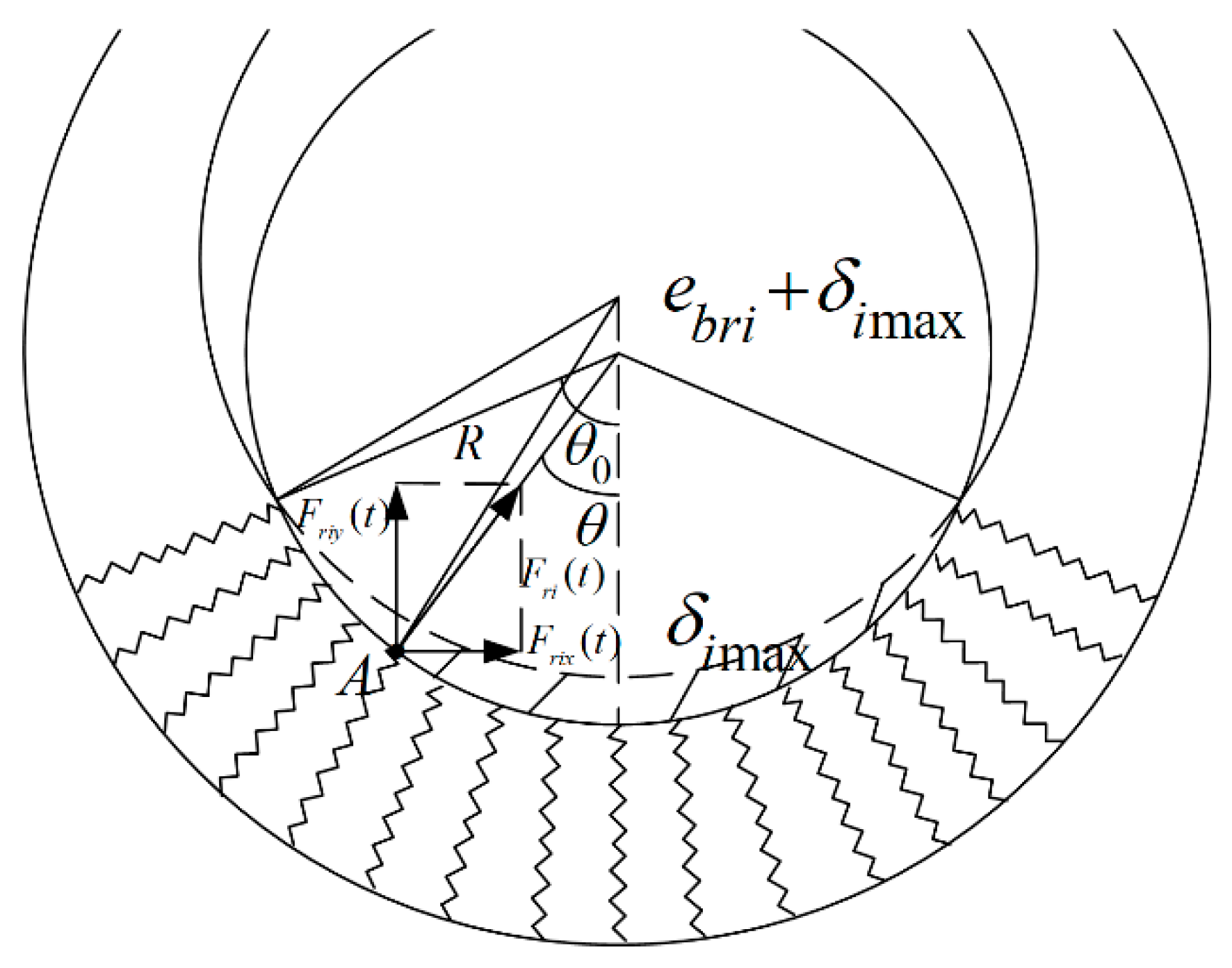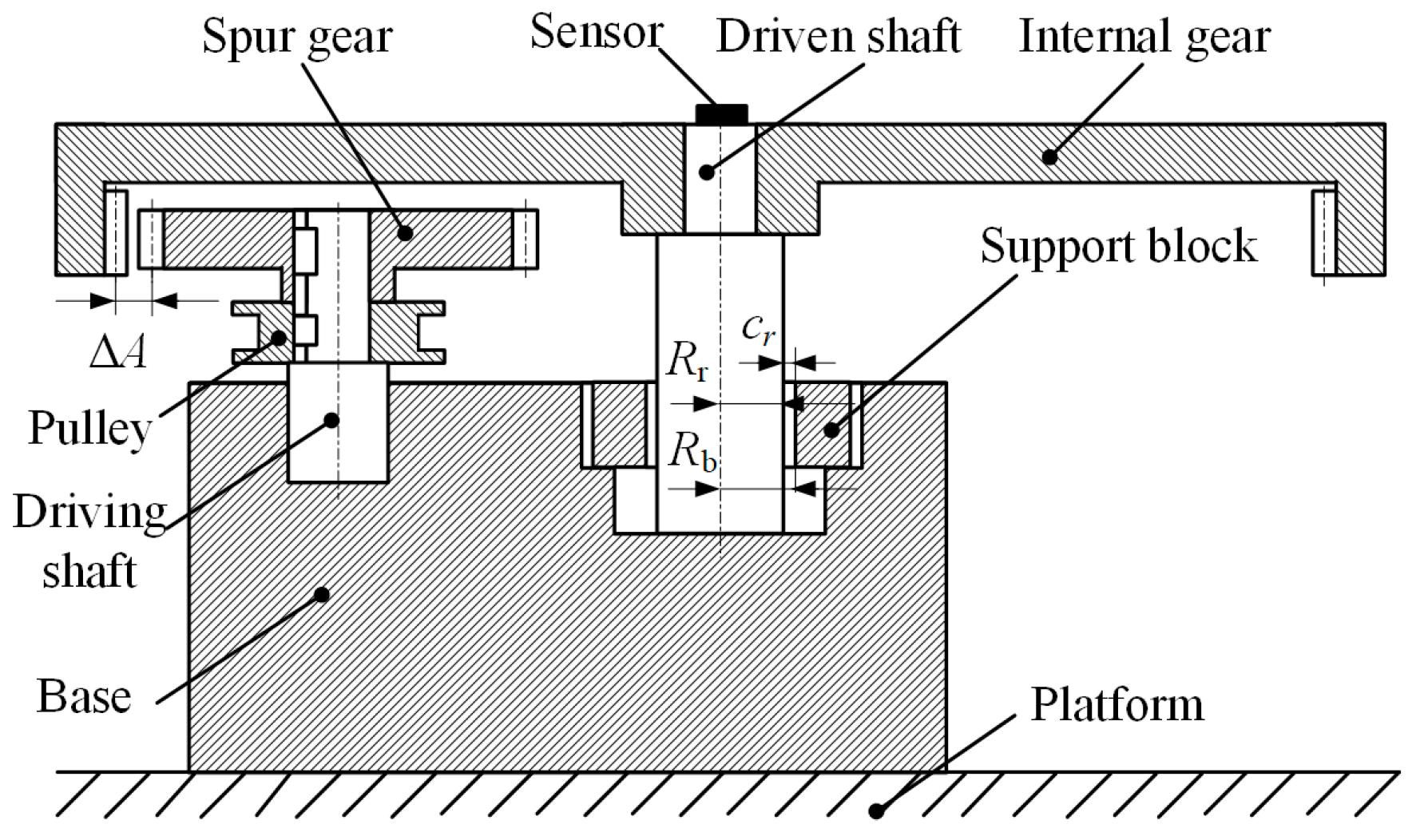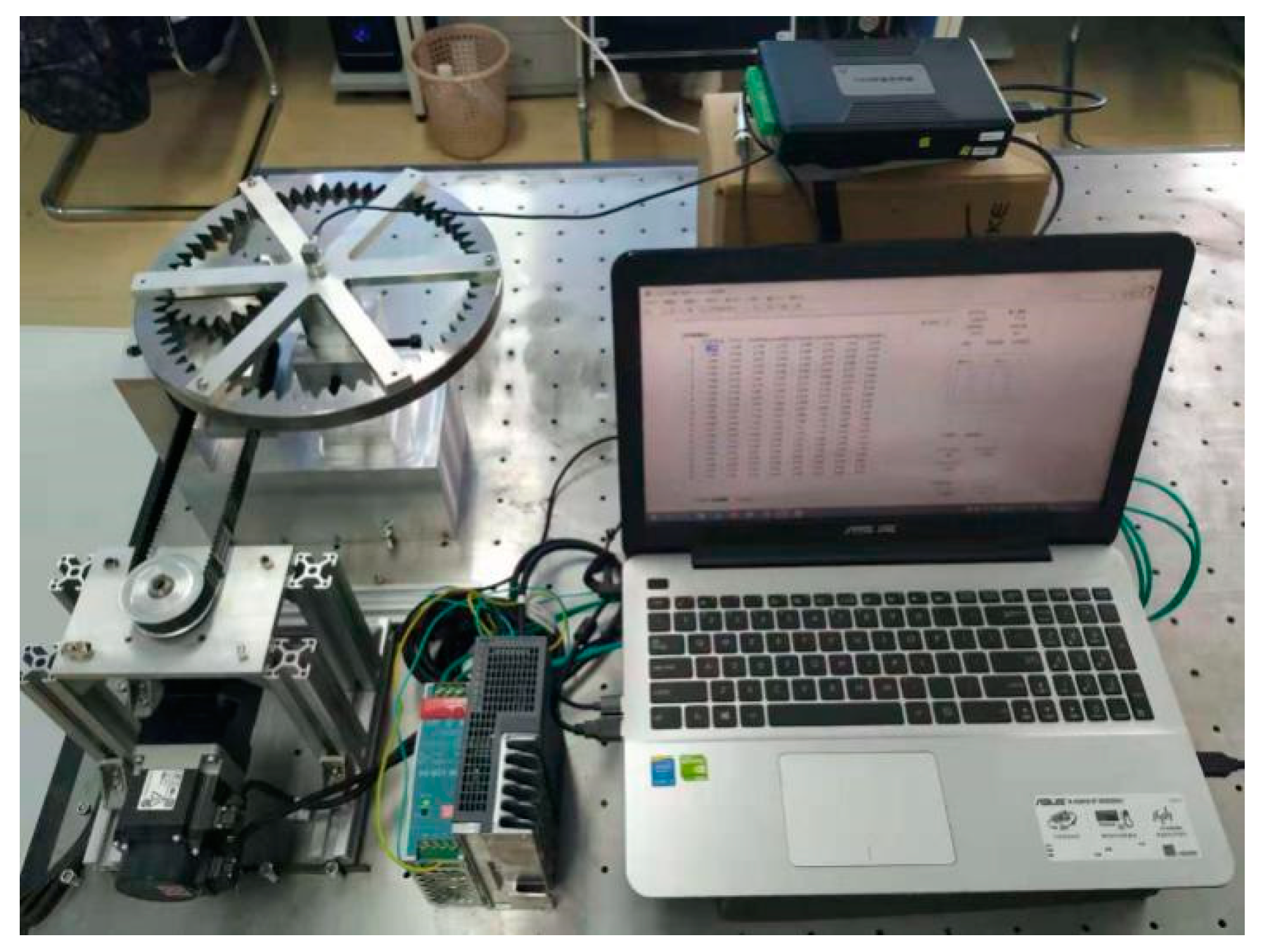Dynamics Modeling and Experimental Investigation of Gear Mechanism with Coupled Small Clearances
Abstract
:1. Introduction
2. Dynamic Model of Multi-Clearance Internal Gear Mechanism System
2.1. Multi-Clearance Coupled Model
2.2. Radial Collision Force Model and Gear Meshing Force Model
2.3. Gear System Dynamic Mode
3. Analysis of Vibration Characteristics of Gear Rotor System
3.1. Study on Dynamic Characteristics of Gear Considering Multi-Clearance Coupling at Different Rotation Speeds
3.2. Study on Gear Dynamic Characteristics Considering Multi-Clearance Coupling under Different Clearance Sizes
4. Conclusions
Author Contributions
Funding
Data Availability Statement
Conflicts of Interest
References
- Xu, L.X.; Yang, Y.H.; Li, Y.G.; Li, C.N.; Wang, S.Y. Modeling and analysis of planar multibody systems containing deep groove ball bearing with clearance. Mech. Mach. Theory 2012, 50, 69–88. [Google Scholar] [CrossRef]
- Onesmus, M.; John, K.; Bernard, I. Numerical study of parametric effects on the dynamic response of planar multi-body systems with differently located frictionless revolute clearance joints. Mech. Mach. Theory 2012, 53, 30–49. [Google Scholar]
- Flores, P.; Lankarani, H.M. Spatial rigid-multibody systems with lubricated spherical clearance joints: Modeling and simulation. Nonlinear Dyn. 2010, 60, 99–114. [Google Scholar] [CrossRef]
- Kahraman, A.; Singh, R. Non-linear dynamics of a geared rotor-bearing system with multiple clearances. J. Sound Vib. 1991, 144, 469–506. [Google Scholar] [CrossRef]
- Petry-Johnson, T.T.; Kahraman, A.; Anderson, N.E.; Chase, D.R. An experimental investigation of spur gear efficiency. J. Mech. Des. 2008, 130, 523–538. [Google Scholar] [CrossRef] [Green Version]
- Ligata, H.; Kahraman, A.; Singh, A. An experimental study of the influence of manufacturing errors on the planetary gear stresses and planet load sharing. J. Mech. Des. 2008, 130, 149–158. [Google Scholar] [CrossRef]
- Hotait, M.A.; Kahraman, A. Experiments on the relationship between the dynamic transmission error and the dynamic stress factor of spur gear pairs. Mech. Mach. Theory 2013, 70, 116–128. [Google Scholar] [CrossRef]
- Byrtus, M.; Zeman, V. On modeling and vibration of gear drives influenced by nonlinear couplings. Mech. Mach. Theory 2011, 46, 375–397. [Google Scholar] [CrossRef]
- Farère, R.; Velex, P. Influence of clearances and thermal effects on the dynamic behavior of Gear-Hydrodynamic journal bearing systems. J. Vib. Acoust. 2013, 135, 807–821. [Google Scholar]
- Farshidianfar, A.; Saghafi, A. Bifurcation and chaos prediction in nonlinear gear systems. Shock. Vib. 2014, 1, 1–8. [Google Scholar] [CrossRef]
- Fernandez-Del-Rincon, A.; Garcia, P.; Diez-Ibarbia, A.; De-Juan, A.; Iglesias, M.; Viadero, F. Enhanced model of gear transmission dynamics for condition monitoring applications: Effects of torque, friction and bearing clearance. Mech. Syst. Signal Process. 2017, 85, 445–467. [Google Scholar] [CrossRef]
- Xiang, L.; Zhang, Y.; Gao, N.; Hu, A.; Xing, J. Jingtang Nonlinear dynamics of a multistage gear transmission system with multi-clearance. Int. J. Bifurc. Chaos 2018, 28, 1850034. [Google Scholar] [CrossRef]
- Sheng, D.; Zhu, R.; Lu, F. Bifurcation characteristics of bending-torsional coupled gear nonlinear vibration with multi-clearance. J. Vib. Shock 2014, 33, 116–122. [Google Scholar]
- Zhang, H.-B.; Wang, R.; Chen, Z.-K.; Wei, C.; Zhao, Y.; You, B.-D. Nonlinear dynamic analysis of a gear-rotor system with coupled multi-clearance. J. Vib. Shock 2015, 34, 144–150. [Google Scholar]
- Al-shyyab, A.; Kahraman, A. A Non-linear dynamic analysis of a multi-mesh gear train using multi-term harmonic balance method: Sub-harmonic motions. J. Sound Vib. 2005, 279, 417–451. [Google Scholar] [CrossRef]










| Equipment Name | Model | The Main Parameters | Value |
|---|---|---|---|
| DC servo Motor | MR-JE-20A | Power (W) | 200 |
| Voltage (V) | 220 | ||
| Acceleration sensor | 356A02 | Sensitivity (mv/(m/s2)) | 1.02 |
| Range (m/s2) | ±4900 | ||
| Signal collector | USB3200 | Sampling frequency (kHz) | 100 |
| Parameter | Value | Parameter | Value |
|---|---|---|---|
| Number of driving gear teeth | 20 | Quality of driving wheel kg | 0.235 |
| Number of driven gear teeth | 60 | Quality of driven wheel kg | 0.800 |
| Modulus | 4 | rotational inertia of the driving wheel kg·m2 | 0.0189 |
| Pressure angle° | 20 | Rotational inertia of the driven wheel kg·m2 | 0.0612 |
| Rotating Speed (rpm) | Test Results (Hz) | Coupled Model | Uncoupled Model | ||
|---|---|---|---|---|---|
| Frequency (Hz) | Error (%) | Frequency (Hz) | Error (%) | ||
| 60 | Radial vibration: 1.642 | 1.327 | 19.18 | 1.289 | 21.49 |
| 60 | 1 times frequency of meshing vibration: 19.885 | 19.959 | 0.37 | 19.767 | 0.59 |
| 60 | 2 times frequency of meshing vibration: 39.991 | 39.926 | 0.14 | 39.765 | 0.56 |
| 120 | Radial vibration: 2.856 | 2.471 | 15.58 | 3.253 | 13.90 |
| 120 | 1 times frequency of meshing vibration: 39.991 | 39.935 | 0.14 | 40.341 | 0.88 |
| 120 | 2 times frequency of meshing vibration: 80.172 | 79.293 | 1.09 | 79.532 | 0.80 |
| 180 | Radial vibration: 3.033 | 3.278 | 8.08 | 3.344 | 10.25 |
| 180 | 1 times frequency of meshing vibration: 60.112 | 60.221 | 0.18 | 59.782 | 0.549 |
| 180 | 2 times frequency of meshing vibration: 120.015 | 119.845 | 0.14 | 120.311 | 0.25 |
| Rotating Speed (rpm) | Test Results (m/s2) | Coupled Model | Uncoupled Model | ||
|---|---|---|---|---|---|
| Amplitude (m/s2) | Error (%) | Amplitude (m/s2) | Error (%) | ||
| 60 | Radial vibration: 42.673 | 38.154 | 10.59 | 33.921 | 20.51 |
| 60 | 1 times frequency of meshing vibration: 7.961 | 8.116 | 6.94 | 7.209 | 9.45 |
| 60 | 2 times frequency of meshing vibration: 6.404 | 6.268 | 2.12 | 6.236 | 2.62 |
| 120 | Radial vibration: 94.282 | 97.852 | 3.79 | 38.327 | 59.35 |
| 120 | 1 times frequency of meshing vibration: 20.152 | 20.307 | 0.77 | 15.831 | 21.44 |
| 120 | 2 times frequency of meshing vibration: 16.622 | 17.132 | 8.48 | 8.639 | 48.03 |
| 180 | Radial vibration: 78.746 | 73.499 | 6.67 | 58.276 | 25.99 |
| 180 | 1 times frequency of meshing vibration: 18.317 | 17.137 | 6.44 | 11.348 | 38.05 |
| 180 | 2 times frequency of meshing vibration: 14.378 | 11.382 | 20.84 | 9.819 | 31.71 |
| Clearance Size | The Test Results (Hz) | Coupled Model | Non-Coupled Model | |||
|---|---|---|---|---|---|---|
| Radial Direction (μm) | Tooth Side (μm) | Frequency (Hz) | Error (%) | Frequency (Hz) | Error (%) | |
| 200 | 100 | The radial vibration: 1.879 | 1.591 | 15.33 | 2.212 | 17.72 |
| 200 | 100 | Meshing 1 times frequency: 40.109 | 40.122 | 0.03 | 40.753 | 1.61 |
| 200 | 100 | Meshing 2 times frequency: 80.111 | 80.213 | 0.13 | 79.533 | 0.72 |
| 100 | 200 | diametral vibration: 2.463 | 1.732 | 29.67 | 2.250 | 8.65 |
| 100 | 200 | Meshing 1 times frequency: 40.895 | 40.330 | 1.38 | 40.253 | 1.57 |
| 100 | 200 | Meshing 2 times frequency: 80.719 | 79.926 | 0.98 | 79.114 | 1.99 |
| 200 | 200 | The radial vibration: 1.920 | 1.700 | 11.46 | 2.512 | 30.83 |
| 200 | 200 | Meshing 2 times frequency: 40.094 | 40.167 | 0.18 | 40.122 | 0.07 |
| 200 | 200 | Meshing 2 times frequency: 80.124 | 79.916 | 0.26 | 80.250 | 0.15 |
| Clearance Size | The Test Results (m/s2) | Coupled model | Non-Coupled Model | |||
|---|---|---|---|---|---|---|
| Radial Direction (μm) | Tooth Side (μm) | Frequency (m/s2) | Error (%) | Amplitude (m/s2) | Error (%) | |
| 200 | 100 | The radial vibration: 86.923 | 86.488 | 0.50 | 55.173 | 36.53 |
| 200 | 100 | Meshing 1 times frequency: 29.065 | 31.228 | 7.44 | 27.489 | 5.42 |
| 200 | 100 | Meshing 2 times frequency: 25.347 | 25.899 | 2.18 | 16.976 | 33.03 |
| 100 | 200 | The radial vibration: 66.735 | 60.554 | 9.26 | 51.248 | 23.21 |
| 100 | 200 | Meshing 1 times frequency: 22.395 | 21.274 | 5.00 | 18.243 | 18.54 |
| 100 | 200 | Meshing 2 times frequency: 17.121 | 18.506 | 8.09 | 13.301 | 22.31 |
| 200 | 200 | The radial vibration: 77.265 | 62.095 | 19.63 | 48.947 | 36.65 |
| 200 | 200 | Meshing 1 times frequency: 22.798 | 20.289 | 11.01 | 16.719 | 26.67 |
| 200 | 200 | Meshing 2 times frequency: 18.546 | 16.245 | 12.41 | 10.845 | 41.52 |
Publisher’s Note: MDPI stays neutral with regard to jurisdictional claims in published maps and institutional affiliations. |
© 2021 by the authors. Licensee MDPI, Basel, Switzerland. This article is an open access article distributed under the terms and conditions of the Creative Commons Attribution (CC BY) license (https://creativecommons.org/licenses/by/4.0/).
Share and Cite
Han, J.; Liang, L.; Zhang, H.; Zhao, Y. Dynamics Modeling and Experimental Investigation of Gear Mechanism with Coupled Small Clearances. Entropy 2021, 23, 834. https://doi.org/10.3390/e23070834
Han J, Liang L, Zhang H, Zhao Y. Dynamics Modeling and Experimental Investigation of Gear Mechanism with Coupled Small Clearances. Entropy. 2021; 23(7):834. https://doi.org/10.3390/e23070834
Chicago/Turabian StyleHan, Jianchao, Lei Liang, Huibo Zhang, and Yang Zhao. 2021. "Dynamics Modeling and Experimental Investigation of Gear Mechanism with Coupled Small Clearances" Entropy 23, no. 7: 834. https://doi.org/10.3390/e23070834






